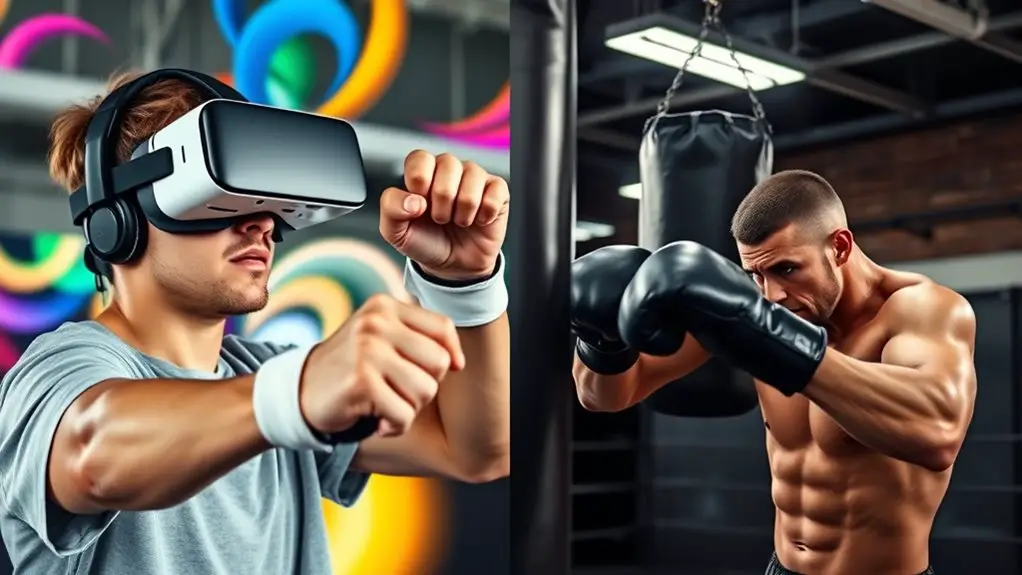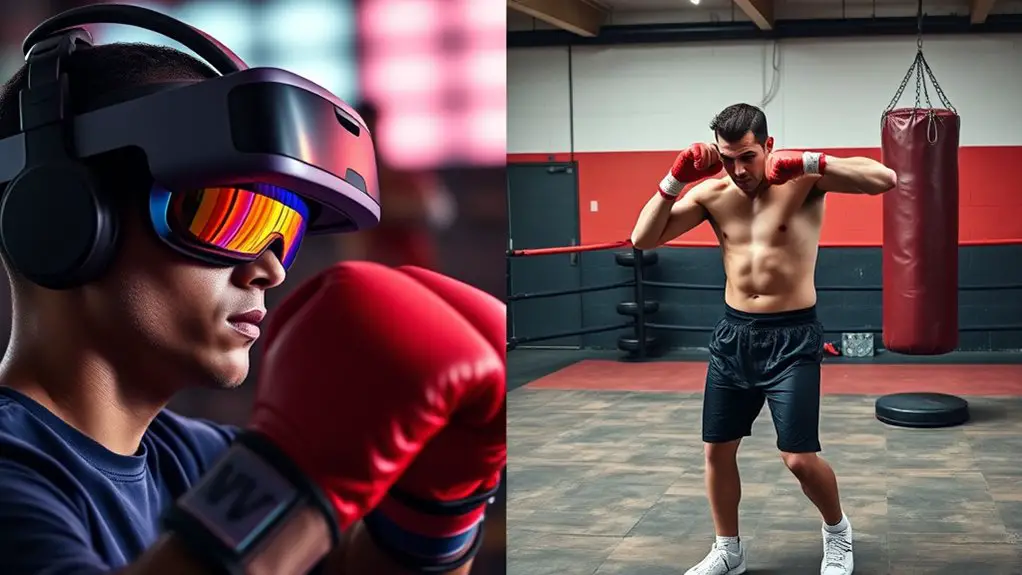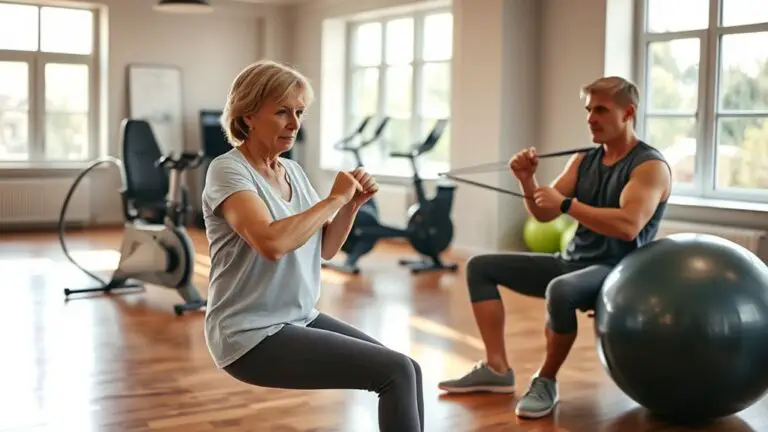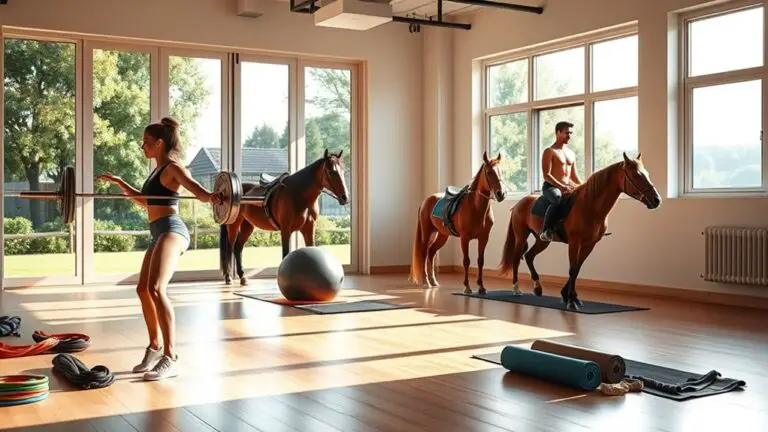How VR Boxing Training Compares to Real Gym Training

VR boxing training offers an immersive experience that makes workouts feel engaging and game-like, unlike traditional gym routines. You get real-time feedback on your punches and footwork, helping you improve quickly. While VR focuses on cardio and skill development, gyms emphasize strength training. Plus, you can train anytime at home, eliminating travel costs. Both methods provide unique benefits, and exploring these differences can help you choose the right fit for your fitness journey.
The Immersive Experience of VR Boxing

When you step into the world of VR boxing, you’re not just putting on a headset; you’re immersing yourself in an electrifying environment that simulates the intensity of a real fight. The immersive environments crafted by VR technology transport you to a virtual ring, where every punch feels tangible. You’re not just shadowboxing; you’re interacting with opponents who react dynamically to your movements.
This heightened realism is enhanced by sensory feedback, which incorporates haptic feedback in your controllers. When you land a punch, you feel a vibration that mimics the impact, reinforcing your connection to the action. This sensory engagement helps you develop your timing and reflexes, as you adapt to the virtual space. The combination of immersive environments and sensory feedback creates a unique training experience, making every session an intense, engaging workout that feels both exhilarating and challenging, pushing your limits in ways traditional training might not.
Skill Development: Virtual vs. Real
While both VR boxing and traditional gym training aim to enhance your skills, they do so through distinctly different approaches. In a VR environment, you can experience immediate feedback mechanisms, allowing you to analyze your punches, footwork, and overall technique refinement in real-time. This instant data can help you make necessary adjustments faster than you might in a gym setting.
On the other hand, training in a real gym offers the advantage of physical interaction. A coach can observe your movements, providing personalized feedback that a virtual system may not capture. This human element can enhance your understanding of technique and instill a deeper sense of discipline.
Ultimately, your choice may depend on your learning style. If you thrive on immediate feedback and visuals, VR might be your best bet. However, if you value hands-on coaching and a social environment, traditional gym training could be more effective for your skill development.
Physical Fitness: Comparing Workouts

Although both VR boxing and traditional gym training can boost your physical fitness, they engage your body in different ways. In a gym, you’ll likely focus on strength training with weights, building muscle and enhancing overall power. These workouts typically require more physical effort and form, challenging your body in a controlled environment.
On the other hand, VR boxing emphasizes cardio workouts. You’re moving constantly, dodging punches and throwing jabs, which elevates your heart rate and increases endurance. The immersive experience can make high-intensity intervals feel more like a game, keeping you motivated and engaged.
While VR offers a unique, fun approach to fitness, it may not fully replace the benefits of traditional strength routines. Combining both methods can lead to balanced physical conditioning, ensuring you build strength and stamina effectively. Ultimately, your choice depends on your fitness goals and personal preferences.
Accessibility and Convenience
When considering boxing training, accessibility and convenience are key factors that can greatly influence your choice. With VR boxing, you can train at home whenever it fits your schedule, eliminating travel time and costs associated with gym memberships. This flexibility not only makes it easier to stay consistent but often proves to be a more budget-friendly option as well.
Home Training Flexibility
As you explore your options for boxing training, you’ll find that home training offers unmatched flexibility regarding accessibility and convenience. You can seamlessly adapt your workouts to fit your personal schedule, making it easier to maintain training consistency. With VR boxing, you can train whenever inspiration strikes, whether it’s early morning or late at night.
| Time of Day | Gym Training | Home Training |
|---|---|---|
| Morning | Commute required | Just put on the headset |
| Afternoon | Limited availability | Always ready |
| Evening | Crowded environment | Peaceful space |
| Weekends | Set class times | Customize your sessions |
| Anytime | Travel needed | No travel, no hassle |
This flexibility empowers you to maximize your potential without the constraints of traditional gyms.
No Travel Required
One of the standout benefits of VR boxing training is the elimination of travel time, making it incredibly accessible and convenient. You can slip on your VR headset and dive right into your workout without wasting precious minutes commuting to a gym. This time savings translates into more flexibility in your schedule, allowing you to fit training sessions around your daily responsibilities. Plus, training at home enhances energy efficiency; you won’t expend energy on travel, leaving you more focused and energized for your workout. With VR boxing, you can engage in high-intensity training whenever it suits you, making it easier to maintain consistency and push your limits without the barriers of traditional gym routines.
Cost-Effective Options
While traditional gym memberships can come with hefty fees and hidden costs, VR boxing training offers a more budget-friendly alternative. You can invest in a VR headset and boxing software without the monthly fees typical of gyms. Plus, many platforms provide virtual discounts, making it even easier on your wallet.
With VR training, you’ll save on travel expenses and additional costs like personal training sessions or classes. You can train on your schedule, avoiding late fees for missed sessions. This accessibility means you’re more likely to stick with your training routine. Overall, VR boxing not only provides effective workouts but also serves as a cost-efficient option for anyone looking to get fit without breaking the bank.
Social Interaction in Training
Though both VR boxing training and real gym training offer unique benefits, the social interaction aspect can greatly impact your overall experience and motivation. In a traditional gym, you’ll find a tangible community where you can engage with fellow boxers, share tips, and feel the energy of group workouts. This community engagement can push you to train harder and stay committed.
On the other hand, VR boxing creates a different kind of connection through virtual camaraderie. You can train with friends or join global competitions, interacting with users from around the world. While you won’t get the physical presence of gym buddies, the shared experience in a virtual space can still foster motivation and accountability. Ultimately, the choice between these environments comes down to your preference for real-life interaction versus the innovative potential of VR. Each has its own charm, and understanding this can help shape your training journey.
Cost Considerations

When considering the cost of boxing training, it’s essential to weigh the financial commitments of both VR and real gym options. If you’re facing budget constraints, VR training can be a more affordable choice. Most VR systems require an initial investment in hardware, but once you’ve got that, you often avoid ongoing fees like gym memberships.
On the other hand, real gyms typically charge monthly fees, and you may also need to invest in personal training sessions. Additionally, don’t forget about equipment costs; while VR might need just a headset and controllers, traditional boxing requires gloves, wraps, and sometimes even sparring gear.
Evaluate your priorities—if you value social interaction and hands-on coaching, a gym might justify the expense. But if you’re looking for flexibility and lower costs, VR training could fit your budget better. Ultimately, it’s about finding what suits your financial situation and training goals.
Long-Term Engagement and Motivation
As you commence your boxing journey, maintaining long-term engagement and motivation can be challenging, especially when comparing VR training to traditional gym experiences. VR boxing offers immersive environments that can keep you excited and engaged, but it’s essential to incorporate goal setting and progress tracking to sustain your motivation.
In a VR setting, you can set specific targets, like improving your punch speed or accuracy, which can be visually tracked through the software. This real-time feedback creates a sense of achievement, pushing you to aim for more.
On the other hand, traditional gym training often relies on personal trainers or workout partners for accountability. While both methods can foster motivation, VR training allows for a personalized experience that you can access anytime, making it easier to stay committed. Ultimately, it’s about finding the balance between the engaging tech of VR and the accountability found in traditional gym settings.
Frequently Asked Questions
Can VR Boxing Training Improve My Reflexes and Reaction Times?
Imagine you’re a cat, poised and ready to pounce. Just like that feline, improving your reflexes and reaction times is vital. VR boxing training can act as your digital playground, offering reflex drills and reaction exercises that sharpen your skills. With immersive scenarios that mimic real-life situations, you’ll find yourself responding faster and with more precision. So, if you’re looking to enhance your agility, VR might just be your new best friend!
Is VR Boxing Safe for Beginners With No Prior Experience?
Yes, VR boxing can be safe for beginners, but you should prioritize beginner safety. Make sure you have the right equipment, like a well-fitted headset and sensors, to avoid accidents. Start in a clear space to prevent injuries from collisions. It’s also wise to follow the game’s tutorials and take breaks to prevent fatigue. With the right precautions, you can enjoy the benefits of VR boxing while minimizing risks as you learn the basics.
How Do I Choose the Best VR Boxing System for My Needs?
Choosing the right VR boxing system is like picking the perfect glove for a fighter; it needs to fit just right. Start by evaluating system features that matter to you, like tracking accuracy and workout variety. Don’t forget budget considerations; the best system doesn’t always mean the most expensive. Research user reviews and compare options to find a balance between quality and cost, ensuring your virtual training journey packs a punch without breaking the bank.
Can VR Boxing Training Help With Mental Toughness and Focus?
Absolutely, VR boxing training can boost your mental toughness and focus. By immersing yourself in a virtual environment, you’ll encounter challenges that require quick decision-making and concentration, enhancing your mental resilience. The realistic simulations can push your limits, forcing you to stay engaged and focused, which translates into improved performance. As you practice, you’ll find that your ability to maintain concentration under pressure strengthens, helping you tackle both physical and mental challenges effectively.
What Are the Potential Drawbacks of VR Boxing Training?
When considering VR boxing training, you might encounter some potential drawbacks. One major concern is virtual limitations; while VR can simulate various scenarios, it can’t replicate the physical intensity of real-life sparring. Additionally, the equipment costs can be significant, as high-quality VR headsets and fitness gear can strain your budget. These factors may affect your overall experience and progress, making it essential to weigh the pros and cons before diving into VR training.





